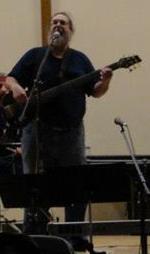This is mark Joseph “young” blog entry #155, on the subject of Driving on Ice and Snow.
Let’s start with the obvious disclaimers.
I am not what is normally termed a professional driver, although I have had a few jobs in which I was paid to do work that included driving as part of the job and have worked with professional drivers. I am not one of those “ice truckers”, and I have no particular qualifications for this.
However, I grew up in that part of northern New Jersey, in the foothills of the Ramapo Mountains, where there is a lot of snow in the winter, and I “cut my teeth” driving in Massachusetts during two of the worst winters on record (1978-79), so I have significant experience driving in and on snow and ice. More to the point, I am not afraid of the stuff, and although I have been in several automotive accidents over the decades, the only one which involved snow or ice at all was a slide into a drift that did no damage to anything. So I am going to be presumptive enough here to suggest that I know something about how to do this.
There are, I suppose, some obvious points that should be made. You can’t force a vehicle through snow that the undercarriage does not clear–you’ll simply raise the car to the point that the tires have no traction. With enough forward momentum you might force your way through, but everything is against you in this. That’s why trucks with large tires do better than low-slung sports cars, or at least, that’s one reason. (The weight also helps.) Traction matters. As we noted in web log post #154: The Danger of Cruise Control, having good tread on your tires helps. They still make studded tires for winter use, and they make chains, and these increase your traction, the degree to which you grip the road, and so the control you have over the vehicle. They are not necessities; they are helpful particularly if you are doing a great deal of winter driving on packed snow or ice. Some states have laws concerning when these are permitted to be on a vehicle on the road, because they provide significant traction by digging into the road surface. My assumptions here are that you have ordinary radial tires, hopefully in decent shape.
The essential rule of driving in snow and ice can be summarized as avoid jerk.
That is not “avoid jerks”, although that is also an important point, and you want to give them plenty of space and be sure that you are not one of them. However, jerk is a technical term in physics which refers to abrupt changes in acceleration, and acceleration means any change in any vector of motion, and a vector of motion means the velocity and direction of movement of an object. Thus hitting the gas to propel yourself forward is jerk, but so is abruptly slowing or stopping, and indeed turning sharply and suddenly is also jerk. These are all to be avoided. Nearly everything else is a detail of that.
One of those details is try to avoid coming to a complete stop on ice. Dump trucks have a first gear that is only ever used to get a fully-loaded stationary vehicle moving at one to two miles per hour so that second gear can take over. The problem with being stopped is that the amount of push needed to get out of stationary momentum is significantly greater than the amount needed to change that rate of motion otherwise, and on ice you might not have the traction to get that push. Of course, you have to stop at traffic lights if they are red–but you can anticipate this. If you see that a light is red, or about to turn red, and you are some distance from it, decelerate and let it cycle back to green while you approach it more slowly. You might not have to stop if it turns green before you reach it. If you do find yourself stopped on a slick surface, remember that the only way to start moving is to do so extremely gradually, because your tires will spin if you push too hard, and in spinning they will make the surface slicker (for reasons we will cover).
Similarly, stay well behind the car in front of you, and particularly if it is moving considerably more slowly than the speed at which you feel comfortable. Slow moving vehicles operated by nervous drivers are one of the biggest hazards on frozen roads, so although you should not drive faster than the speed at which you are comfortable, you should not go too slowly, either, as it increases the probability that you will become stuck in deeper snow if you hit a patch that slows the vehicle–having some momentum will keep you out of many problems. If you are behind a slower vehicle, it is unlikely in the extreme that the conditions will be conducive to passing, so there’s no point crowding while awaiting that opportunity. The closer you are, the less chance you have to react safely to any mistake the other driver makes, and honestly with you on his bumper he is going to be more nervous and more prone to making one of those mistakes.
There is another reason why you want to be particularly attentive to the car in front of you: his motions will help you predict road conditions ahead. If he swerves or fishtails, or abruptly slows, odds are good that there is something in the road at that point that caused him to do so. It’s possible that he’s just distracted, or drunk, or otherwise impaired, but if he has been driving well to this point and suddenly makes an unexpected movement, you should be wary for trouble of some sort. His movements will also indicate where he believes the road is going in poor visibility conditions, giving you time to anticipate curves. Just don’t follow him into a driveway–or a snowbank.
Keep your attention focused not only on the other vehicles, from which you are trying to maintain a more than safe distance, but also on the road surface ahead. At night (if there is no fog) use your high beams whenever there is no oncoming traffic and you are far enough behind any vehicle in front of you. If there is a change in the road’s appearance, begin reducing your speed before you reach it. Once you know what kind of traction you have on the new surface you can resume your previous speed if appropriate. Do this even if the change appears to be for the better, because the appearance of the road from a distance might not accurately reflect the actual conditions.
As to road surfaces, a clean dry surface is your best friend. Sand atop snow is usually next, or sand atop ice; dry sand on a dry road creates its own sliding problems, but of a different sort. A thin layer of loose snow will give better traction than either packed snow or roughened ice, which are nearly the same. However, loose snow can obscure potholes and other road hazards. Slush also can obscure potholes, and is considerably less predictable. A bit of dryer slush can give you traction similar to loose snow. Wet slush on a road surface is more akin to driving through puddles, with the hazards of hydroplaning but reasonable traction when you are moving slowly enough to grip the road. Slush atop ice is slicker than simple packed ice. This is important partly because you want to know what kind of traction you are going to have on the road ahead so as to adjust your speed accordingly, and because it is often the case that you can position your wheels on one type of surface or another. For example, if traffic has caused there to be a pair packed smooth ice pathways along the usual tire paths but there is loose snow down the center and to the edges, you can shift slightly toward one edge and take advantage of the better traction of the snow.
Let me mention so-called “black ice”, mostly because if I don’t someone will note that I didn’t. This is in essence a very thin layer of smooth ice which occurs when melt refreezes, usually in situations in which a warm day or intense sunlight has warmed the road slightly and the cooling of evening or night has refrozen it. It is essentially driving on ice, but it more difficult to spot as it is thin enough to see the road surface through it and so looks very like a simple wet road, if a bit more shiny. It does not usually form on very busy roads because the constant warming from traffic disperses and evaporates it.
You should also be aware of changing road circumstances. There are several ways in which the lay of the road, the construction of it, can impact driving conditions. The best known of these is bridges, but you should also be wary of causeways and open fields.
We have all seen the signs which incorrectly read “Bridge Freezes Before Road Surface”. The correction of “Freezes” to “Ices” helps, but it is more helpful to understand what is happening. Roads absorb heat, particularly from the sun and even on sub-freezing days. Dark macadam roads absorb more than lighter-colored more reflective concrete ones. That heat is transfered into the ground below, which acts as ballast. When the temperature starts dropping and the sun vanishes, the road starts surrendering its heat, but sub-freezing atmosphere will not create ice so quickly on a warmed road surface until the road itself nears the freezing mark after having drawn the stored heat from below. However, with a bridge there is a thin layer of paving over a thin support structure, and a large space beneath through which air moves, drawing the heat out of the road from all sides. Thus the road surface on the bridge will reach the icing point sooner than the road surface elsewhere. Of course, if the air has not reached the freezing mark the water on the bridge won’t freeze. In fact, when the world starts warming the reverse effect occurs: the bridge de-ices before the road surface, as it will warm through quickly while the heat hitting the road elsewhere will take time to penetrate.
This is also important, because although we say that we slip on the ice, it’s not exactly correct. We actually slip on the water. Skiers, ice skaters, and bobsledders all understand that what makes them move is the fact that the friction between their blades and the frozen surface creates a thin sheen of water between the blade and the ice, and the blade floats atop this bit of water. (There was a horrible accident in Lake Placid in the early 1970s when one international bobsled team decided to apply a blowtorch to the runners on their sled before making the run. They exceeded all previous speeds, were unable to slow themselves, and sailed off the track into the trees at a tight turn. If memory serves, they had exceeded eighty miles per hour.) That means that icy roads are most dangerous when they are just freezing or just thawing, considerably less so when the ice is so frozen that the heat of the tires has minimal effect.
Causeways and open fields have a similar, but less marked, effect because they are open to the wind, and so wind chill is a significant factor. Again, wind chill does not mean that the air is colder. It means that the air warmed by a warm object is being replaced faster than the object can warm it, with the result that the warm object cools more quickly. A strong wind two degrees above freezing will rapidly chill anything warmer than that until it is two degrees above freezing; it won’t freeze anything. It is bad for you because your body is working to keep warm, so it makes you feel colder and uses more of your energy. (Technically that “cooling breeze” on a hot summer day is wind chill; we just don’t call it that because we welcome it.) It is similarly bad for your house, because the heating system has to work harder, and for the interior of your car if you are trying to stay warm in it. However, that same wind just above freezing will more rapidly melt ice and snow on an open road, because it is warming it more quickly, replacing the chilled air immediately above the surface with slightly warmer air (the reason we can cool hot food by blowing on it with our breath despite the fact that the air coming out of our mouth is warmer than the room temperature air). Because causeways and fields are open to the wind, they are more susceptible to changes from wind chill and warming.
Open fields also present a hazard from drifts. Of course, if the drifts are deep they may become an impassable obstacle; but the more dangerous drift problem is the repeated dusting of powder which coats the road and becomes ice on top of previously placed sand or salt. Many locales erect snow fences along the edges of fields to collect blowing snow before it reaches the road, but these are never completely effective.
Knowing what the road ahead is like is a very valuable asset in negotiating snow and ice.
It is advice so commonly repeated that you have almost certainly heard it: if you are sliding or skidding on any surface, turn in the direction of the skid. That, though, is just what, not why, and it is so counter-intuitive that most people do not grasp even that it works. After all, if you are sliding in a direction you don’t want to go, the natural reaction is to try to steer in the direction you do want to go, and when that doesn’t work you panic trying to get the car to go a different way; why would you tell it to go the way it is already going? However, when you are sliding or skidding, your front tires are not more than two blunt feet, and you can turn them any way you like but they will keep sliding just like blunt feet–unless you manage to get them rolling in harmony with your actual movement. The only way to get them rolling is to align them with that movement, and then–again remembering to avoid sudden changes in direction–ease the new direction on the front end of the car by turning gradually in a better direction. That is how you recover control of the car.
If you have been stuck in snow, you have undoubtedy noticed that one wheel will spin rapidly while the other does nothing at all. This is a significant effect of an important design feature of the car. Whenever you drive around a turn, the wheels toward the outside of the curve trace a longer arc than those to the inside. That means that one of your wheels is moving farther than the other and has to turn faster. If the drive wheels (whether rear wheel or front wheel drive) were linked absolutely, one or the other would have to slip on the surface, which means it would necessarily require the ability to slip against the road and would wear down the tires much more quickly. To avoid this, the vehicle has a piece in the drive called a differential, the function of which is to shift the majority of the power to the wheel that is spinning faster. The downside of this is that if one tire starts to slip, it will spin, and the other will be given a negligible amount of push, and you will be stuck.
That spinning tire is a problem for more reason than that it isn’t gripping and is wasting all your motive power. The friction of the spin, even on ice, makes the tire itself hotter, and the hotter tire melts the ice more quickly, creating that layer of water that impedes grip and which quickly refreezes into a smoother, slicker surface. Many people carry something in their cars to put under such tires to increase traction–salt, sand, and cat litter are probably the favorites, and all are good, but just about anything rough you can put under the spinning tire–pine needles, small branches, leaves, boards, clothing, floor mats, confetti, rice, birdseed–will increase the traction and help get you out of the hole the tire is digging.
It often happens that the spinning tire will create a ridge in front of itself that is increasingly more difficult for it to surmount, particularly if there was snow piled in front of the tire initially. One very good way to free such a tire is to dig out the space immediately in front of it so that when it starts moving forward it will be moving downward, giving it momentum to continue beyond that. It also sometimes helps to “rock” the car, that is, back it slightly then move it forward repeatedly, as if you can get the car to move a little you can in essence extend the rut and give yourself something of a “runway” to get the needed momentum.
If you find that the conditions in which you are driving have you frequently getting stuck in snow, you should give serious consideration to snow tires, studded tires, or chains for the winter months.
All of these have to become automatic for you–particularly pulling out of a skid. You often do not have time to think about what the right response to the situation is. It has to be your first reaction. That means you have to practice, and become accustomed to the right responses. You don’t just have to know that you should turn into the direction of the skid when you are sliding, but you have to do it automatically, feel that you have regained rolling motion, and pull out of it without losing that control, all before you have skidded too far. You have to slow down, automatically, when you observe anything ahead that is likely to be a hazard. You have to be aware of the kind of traction you have, and the kind of traction that you are likely to have on the road ahead, and keep a good distance from anyone else on the road to the degree that it is your choice. Just as you have learned how to steer, how to slow and stop, how to use your turn signals and dim your brights all without stopping to think about it, you have to use these safety techniques as part of “this is how you drive”. So you have to get out on the ice, in the snow, and learn to do it.
Incidentally, I know from experience that old tire chains in good repair make excellent ladders for tree forts.
[contact-form subject='[mark Joseph %26quot;young%26quot;’][contact-field label=’Name’ type=’name’ required=’1’/][contact-field label=’Email’ type=’email’ required=’1’/][contact-field label=’Website’ type=’url’/][contact-field label=’Comment: Note that this form will contact the author by e-mail; to post comments to the article, see below.’ type=’textarea’ required=’1’/][/contact-form]









